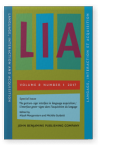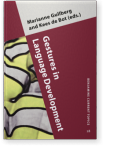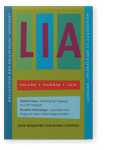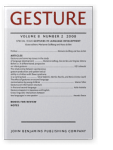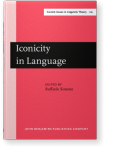Virginia Volterra
List of John Benjamins publications for which Virginia Volterra plays a role.
Journal
Title
Italian Sign Language from a Cognitive and Socio-semiotic Perspective: Implications for a general language theory
Virginia Volterra, Maria Roccaforte, Alessio Di Renzo and Sabina Fontana
[Gesture Studies, 9] 2022. vi, 220 pp.
Subjects Cognition and language | Gesture Studies | Semiotics | Signed languages
2022 Searching for the roots of signs in children’s early gestures Gesture 21:2/3, pp. 201–238 | Article
A consolidated tendency considers ‘gestures’ and ‘signs’ as distinct categories separated by a ‘cataclysmic break’. According to a different approach, gestures and signs have their common origin in actions, and are considered as part of language. The aim of this study was to compare the… read more
2020 The comparative neuroprimatology 2018 (CNP-2018) road map for research on How the Brain Got Language How the Brain Got Language – Towards a New Road Map, Arbib, Michael A. (ed.), pp. 370–387 | Chapter
We present a new road map for research on “How the Brain Got Language” that adopts an EvoDevoSocio perspective and highlights comparative neuroprimatology – the comparative study of brain, behavior and communication in extant monkeys and great apes – as providing a key grounding for hypotheses on… read more
2020 Gestural symbolic strategies in children with Down syndrome Gesture 19:2/3, pp. 299–334 | Article
In early communicative development, children with Down syndrome (DS) make extensive use of gestures to compensate for articulatory difficulties. Here, we analyzed the symbolic strategies that underlie this gesture production, compared to that used by typically developing children. Using the same… read more
2020 From action to spoken and signed language through gesture: Some basic developmental issues for a discussion on the evolution of the human language-ready brain How the Brain Got Language – Towards a New Road Map, Arbib, Michael A. (ed.), pp. 216–238 | Chapter
We review major developmental evidence on the continuity from action to gesture to word and sign in human children, highlighting the important role of caregivers in the development of multimodal communication. In particular, the basic issues considered here and contributing to the current debate… read more
2018 The comparative neuroprimatology 2018 (CNP-2018) road map for research on How the Brain Got Language How the Brain Got Language: Towards a New Road Map, Arbib, Michael A. (ed.), pp. 370–387 | Article
We present a new road map for research on “How the Brain Got Language” that adopts an EvoDevoSocio perspective and highlights comparative neuroprimatology – the comparative study of brain, behavior and communication in extant monkeys and great apes – as providing a key grounding for hypotheses… read more
2018 From action to spoken and signed language through gesture: Some basic developmental issues for a discussion on the evolution of the human language-ready brain How the Brain Got Language: Towards a New Road Map, Arbib, Michael A. (ed.), pp. 216–238 | Article
We review major developmental evidence on the continuity from action to gesture to word and sign in human children, highlighting the important role of caregivers in the development of multimodal communication. In particular, the basic issues considered here and contributing to the current debate… read more
2017 Developmental evidence for continuity from action to gesture to sign/word The gesture–sign interface in language acquisition / L’interface geste–signe dans l’acquisition du langage, Morgenstern, Aliyah and Michèle Guidetti (eds.), pp. 13–41 | Article
What is linguistic communication and what is it not? Even if we often convey meanings through visible bodily actions, these are rarely considered part of human language. However, co-verbal gestures have compositional structure and semantic significance, while highly iconic structures are… read more
2011 Naming with gestures
in children with typical development and with Down syndrome Primate Communication and Human Language: Vocalisation, gestures, imitation and deixis in humans and non-humans, Vilain, Anne, Jean-Luc Schwartz, Christian Abry and Jacques Vauclair (eds.), pp. 155–172 | Article
2010 Gestures and some key issues in the study of language development Gestures in Language Development, Gullberg, Marianne and Kees de Bot (eds.), pp. 3–33 | Article
2010 Assessing lexical production in deaf signing children with the Boston Naming Test Acquiring Sign Language as a First Language / Acquisition d’une langue des signes comme langue première, Sallandre, Marie-Anne and Marion Blondel (eds.), pp. 110–128 | Article
A picture naming task, the Boston Naming Test, originally developed for spoken language, has been adapted to Italian Sign Language in order to assess the vocabulary of Italian deaf signing children. Thirty deaf and thirty hearing children and adolescents (aged 6–14 years) participated in the study.… read more
2008 Deaf and hearing children: Reading together in preschool Sign Bilingualism: Language development, interaction, and maintenance in sign language contact situations, Plaza-Pust, Carolina and Esperanza Morales-López (eds.), pp. 137–164 | Article
The present chapter describes an educational experience carried out within the project “Bilingual education towards deaf and hearing children’s integration”. The conceptual framework of the project refers to a bilingual approach which consists in exposing deaf and hearing kindergarten children to… read more
2008 Gesture and speech: The emergence and development of a strong and changing partnership Dimensions of gesture, Kendon, Adam † and Tommaso Russo Cardona (eds.), pp. 22–44 | Article
The present paper focuses on early stages of development exploring the emergence of the gesture language system in infancy and its evolution toward the adult system. Old and recent studies carried on mainly in our Laboratory are described and discussed.
According to the perspective that emerged… read more
2008 Gestures and some key issues in the study of language development Gestures in language development, Gullberg, Marianne and Kees de Bot (eds.), pp. 149–179 | Article
The purpose of the current paper is to outline how gestures can contribute to the study of some key issues in language development. Specifically, we (1) briefly summarise what is already known about gesture in the domains of first and second language development, and development or changes over… read more
2007 From action to language through gesture: A longitudinal perspective Gestural Communication in Nonhuman and Human Primates, Liebal, Katja, Cornelia Müller and Simone Pika (eds.), pp. 139–159 | Article
The present study reports empirical longitudinal data on the early stages of language development. The main hypothesis is that the output systems of speech and gesture may draw on underlying brain mechanisms common to both language and motor functions. We analyze the spontaneous interaction with… read more
2005 From action to language through gesture: A longitudinal perspective Gestural Communication in Nonhuman and Human Primates, Liebal, Katja, Cornelia Müller and Simone Pika (eds.), pp. 155–177 | Article
The present study reports empirical longitudinal data on the early stages of language development. The main hypothesis is that the output systems of speech and gesture may draw on underlying brain mechanisms common to both language and motor functions. We analyze the spontaneous interaction with… read more
2004 Language in preschool Italian children withWilliams and Down syndromes Williams Syndrome across Languages, Bartke, Susanne and Julia Siegmüller (eds.), pp. 163–186 | Article
1995 Terms for Spatio-Temporal Relations in Italian Sign Language Iconicity in Language, Simone, Raffaele (ed.), pp. 237 ff. | Article






